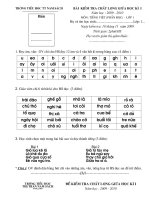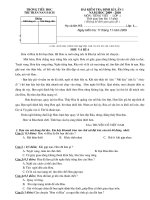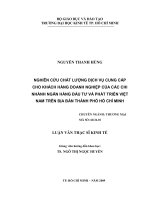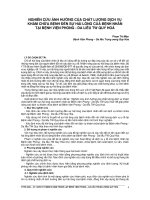Chất lượng dịch tiêu đề film tiếng Anh sang tiếng Việt của Google Translate
Bạn đang xem bản rút gọn của tài liệu. Xem và tải ngay bản đầy đủ của tài liệu tại đây (679.99 KB, 7 trang )
KHOA HỌC
TẠP CHÍ
TRƯỜNG ĐẠI HỌC QUY NHƠN
Chất lượng dịch tiêu đề film tiếng Anh sang tiếng Việt
của Google Translate
Trần Thị Thanh Huyền1,*, Lê Nhân Thành2
Trường THPT dân tộc nội trú Đông Gia Lai, thị xã An Khê, tỉnh Gia Lai, Việt Nam
2
Khoa Ngoại ngữ, Trường Đại học Quy Nhơn, Việt Nam
1
Ngày nhận bài: 09/04/2021; Ngày nhận đăng: 22/08/2021
TÓM TẮT
Google Translate (GT) - một cơng cụ dịch trực tuyến miễn phí - được sử dụng ngày càng phổ biến nhưng
chất lượng dịch của GT chưa thật sự tốt. Bài báo này trình bày kết quả nghiên cứu chất lượng dịch của GT khi dịch
130 tiêu đề phim tiếng Anh sang tiếng Việt. Nghiên cứu này sử dụng phương pháp phân tích nội dung để phân tích
dữ liệu theo hướng định tính và định lượng. Kết quả nghiên cứu cho thấy rằng mặc dù GT khơng mắc phải bất cứ
lỗi hình vị nào, nhưng mắc 4 loại lỗi dịch thuật theo cách phân loại lỗi của Farrús và cộng sự9 với các mức độ rất
khác nhau khi dịch tiêu đề phim. Trong tổng số 130 tiêu đề phim, GT chỉ dịch được 16 tiêu đề phim chính xác và
mắc lỗi khi dịch 114 tên phim. Trong 4 loại lỗi, lỗi ngữ nghĩa chiếm nhiều nhất. Vị trí thứ hai và thứ ba lần lượt
thuộc về các lỗi từ vựng và lỗi cú pháp. Lỗi hình thức đứng ở vị trí tiếp theo. Kết quả này cho biết rằng GT dịch
tiêu đề phim tiếng Anh sang tiếng Việt không tốt. Cuối bài báo có các gợi ý và đề xuất dành cho những người sử
dụng GT, những người phát triển GT và những người nghiên cứu về chất lượng dịch GT.
Từ khóa: Tiêu đề phim tiếng Anh, tiếng Việt, Google Dịch, lỗi dịch thuật, chất lượng dịch.
*Tác giả liên hệ chính.
Email:
/>Tạp chí Khoa học - Trường Đại học Quy Nhơn, 2021, 15(4), 69-75 69
TẠP CHÍ
KHOA HỌC
TRƯỜNG ĐẠI HỌC QUY NHƠN
The quality of Google Translate’s Vietnamese
translations of English film titles
Tran Thi Thanh Huyen1,*, Le Nhan Thanh2
1
Dong Gia Lai ethnic boarding high school, An Khe Town, Gia Lai province, Vietnam
2
Department of Foreign Languages, Quy Nhon University, Vietnam
Received: 09/04/2021; Accepted: 22/08/2021
ABSTRACT
Google Translate (GT), a free online translation tool, is increasingly used, but the translation quality of GT
is not really good. This article presents the results of a study on the quality of GT in translating 130 English film
titles into Vietnamese. The study used content analysis to analyze the data, both qualitatively and quantitatively.
The results show that GT did not make any morphological errors, but it committed orthographic errors, lexical
errors, semantic errors, and syntactic errors at very different rates according to Farrús et al.’s framework9 of
translation errors. Out of 130 English film titles, GT transferred only 16 film titles correctly, and GT made 141
errors in the remaining 114 film titles. Among four error types, semantic errors are the most dominant. The second
and third positions belong to lexical errors and syntactic errors, respectively. Orthographic errors take the last
place. The result of the study indicates that GT fails to translate English film titles into Vietnamese ones. In other
words, the translation quality of GT in translating film titles from English into Vietnamese is low. Implications for
GT users, GT technicians, and other researchers are suggested.
Keywords: English film title, Vietnamese, Google Translate, translation error, translation quality.
1. INTRODUCTION
1.1. Introduction to GT
According to Wikipedia,1 in 2006, GT was
introduced as a statistical machine service.
Because GT used the United Nations and European
Parliament’s transcripts as data, accuracy was
not appreciated. Then GT switched to a new
version of the system for machine-assisted
language translation - Google Neural Machine
Translation, which allows whole sentences to
be translated with more diverse contexts. After
that, GT arranges and adjusts the data to find
the most suitable translations. Currently, GT
uses the Neural Machine Translation system
for most language pairs, and this system gives
more accurate results than other ones. However,
the translation quality of GT depends on the
source of the documents entered into the system.
Accordingly, GT only has standard translation
when it contains the data related to the requested
translation contents. Therefore, to evaluate the
translation quality of GT accurately, researchers
need to study the translation quality of GT in
many different fields. This study investigates the
translation quality of GT in translating English
film titles into Vietnamese.
1.2. Research into the translation quality of GT
Up to now, studies on the translation quality of
GT have not been carried out in various fields.
*Corresponding author.
Email:
/>70 Tạp chí Khoa học - Trường Đại học Quy Nhơn, 2021, 15(4), 69-75
JOURNAL OF
SCIENCE
Q U Y N H O N U N I V E RS I T Y
One of the studies on the quality of GT
was conducted by Luong Kim Hoang.2 The
researcher investigated the common errors
in Vietnamese - English translation of labels
and captions in tourist attractions in Ho Chi
Minh City, Vietnam. The researcher used the
translation error classification of Dastjerdi and
Abdolmaleki3 to examine GT's errors when it
randomly translated 450 selected labels and
captions. The findings show that 96.6% of the
translation versions are incorrect and that there
is no consistent pattern in the most common
translation errors.
Another study investigating the quality
of GT when translating English metaphors into
Vietnamese was conducted by Huynh Ha Mi.4
The data were collected from the novel Kafka on
the Shore by Murakami Haruki. The researcher
employed the theory of Lakoff and Johnson
to identify metaphors and the framework of
Nord5 to discover the occurrences of translation
errors. It can be seen from the findings that
GT translates orientational metaphors better
than other metaphor types, including structural
metaphors and ontological metaphors.
Besides, Lu et al.6 translated ten common
anesthetic pre-assessment questions in the
medical and anesthetic history, and assessment
of the airway from English into ten languages
(Arabic, Filipino, French, German, Greek, Hindi,
Italian, Polish, Spanish and Vietnamese) by
using GT. They concluded that Spanish gets the
most accurate translations of the questions with
80%, and Vietnamese gets the worst translations,
with an accuracy rate of only 10%.
In general, studies on the translation
quality of GT in different fields give different
conclusions on the translation quality of GT.
Therefore, GT's translation quality research
should be done in a more diverse range of text
to get an accurate overview of GT's translation
in general. Accordingly, research on GT’s
translation quality in the entertainment industry,
namely film titles, is needed to enrich the findings
of GT's quality and to enable GT's developers
to have a more specific orientation in improving
the quality of GT in a variety of fields.
1.3. Translation error classifications
Many researchers have been interested
in translation errors. As a result, different
translators have suggested various translation
error frameworks.
One of the most popular frameworks of
detailed error taxonomy in Machine Translation
(MT) is proposed by Stymne and Ahrenberg7
with 10 error types: (1) ER - Error rate, (2) Ling Linguistic categories, (3) GF - grammatical and
function words, (4) Form, (5) POS+ - part-ofspeech, (6) FA - fluency, adequacy, (7) Ser serious, (8) Reo - reordering, (9) Index, (10)
Other. Each error type includes sub-types with
clear descriptions. However, this framework is
not suitable for identifying film title translation
errors. Film titles contain simple words, phrases,
or sentences, so the framework with too many
error types is too complicated to apply.
Another framework that also works with an
inter-annotator agreement is Multidimensional
Quality Metric.8 This framework concerns with
accuracy and fluency and consists of many
complex sub-types. Therefore, it is not easy
to apply this framework to identify film title
translation errors.
The linguistic-based evaluation criteria
for identifying statistical MT errors put
forward by Farrús et al.9 contain orthographic,
morphological, lexical, semantic, and syntactic
errors. Orthographic errors are the errors
of punctuation, capitalization, and spelling.
Morphological errors are related to the forms
(i.e., inflections, often suffixes) of verbs, nouns,
and others (adjectives and adverbs). Lexical
errors include two sub-types: extra words and
missing words. Semantic errors occur when
the wrong meaning of a target word is chosen
to render a source word. Syntactic errors have
five sub-types, namely conjunction, preposition,
/>Journal of Science - Quy Nhon University, 2021, 15(4), 69-75 71
TẠP CHÍ
KHOA HỌC
TRƯỜNG ĐẠI HỌC QUY NHƠN
article, syntactic element reordering, and category
errors. Due to the different characteristics of
languages, it is not easy to find any framework
suitable for all kinds of contexts. The framework
suggested by Farrús et al.9 is not perfect, too.
It does not contain pragmatic errors. However,
Farrús et al.’s framework9 explains translation
error types in detail and is easy to apply at the
level of simple words, phrases, or sentences.
Therefore, this study used this framework to
examine translation errors in GT’s translations
of the English film titles into Vietnamese.
1.4. The characteristics of the film titles
According to Ailan,10 a film title exhibits
linguistic, cultural, and aesthetic properties.
The linguistic characteristics guarantee the
clarity, accuracy, and direct disclosure of the
film's content without too many words. The
cultural characteristics shown in the film title
must reveal the unique culture of each ethnic
group. The aesthetic characteristics are reflected
in the harmonious beauty of image, creativity,
artistry, rhyme, and tone. Together with
accuracy, the translation versions must ensure
the characteristics of film titles.
2. METHODOLOGY
In morphological errors, M1 is verb, M2
is noun, while M3 is other errors.
In lexical errors, an extra word is coded
as L1, and a missing word is coded as L2.
SE represents a semantic error.
In syntactic errors, S1 stands for a
conjunction error, S2 for preposition error,
S3 for article error, S4 for syntactic element
reordering error, and S5 for a category error.
Some translations had no errors. As a
result, one more code, NE, was added for No
Error cases.
The error types identified after the analysis
were recorded in the fifth column. The following
is an illustration of the data storage table.
Table 1. Data preparation table
Valentine
xanh
Lễ tình
nhân
buồn
Error type
Blue
Valentine
Suggested
Vietnamese
translation
GT’s Vietnamese
translation
1
English film title
To prepare the data for analysis, a
4-column table with the following contents was
drawn: column 1 for the ordinal number, column
2 for the English film titles, column 3 for GT's
Vietnamese translations of the English film
titles, and column 4 for suggested Vietnamese
translations of the English film titles. Besides,
the sources of the film titles were also included
in the table.
In orthographic errors, O1 stands for
punctuation, O2 for capitalization and O3 for
spelling.
No
To obtain the data for the present study, 130 film
titles in English were collected from 32 websites.
Among these websites, ipedia.
org/wiki/ is the website where 43.8% of the
film titles were collected. Then these film titles
were translated into Vietnamese by GT, and
the Vietnamese translations were analyzed to
investigate GT’s translation quality.
To analyze the translation errors in the
Vietnamese translations, the linguistic-based
evaluation criteria for identifying statistical MT
errors introduced by Farrús et al.9 were used. The
errors were coded as follows.
SE
Source: />2
12 Years a
Slave
12 năm
nô lệ
12 năm
nơ lệ
NE
Source:
/>
/>72 Tạp chí Khoa học - Trường Đại học Quy Nhơn, 2021, 15(4), 69-75
JOURNAL OF
SCIENCE
Q U Y N H O N U N I V E RS I T Y
3. RESEARCH RESULTS
The analysis of GT’s Vietnamese translations of
130 English film titles showed that GT correctly
translated 16 English film titles, accounting for
12.3%. This means that GT committed errors in
the translations of 114 English film titles, making
up 87.7%.
The Vietnamese translations of 114
English film titles had 141 translation errors
because many of GT’s Vietnamese translations
had more than one translation error.
Specific numbers and frequencies of
translation errors are presented in the following
table.
Table 2. Numbers and frequencies of translation errors
No
Error types
Number
of errors
Percentage
(%)
1
Morphological
errors
0
0
2
Orthographic
errors
6
4.3
3
Syntactic errors
11
7.8
4
Lexical errors
20
14.2
5
Semantic errors
104
73.7
Total
141
100
Table 2 indicates that four broad error
types exist, with a total of 141 instances. The
error types take up very different rates. Among
the errors, semantic errors are dominant, with 104
instances, accounting for 73.7%. The second and
third positions are of lexical errors and syntactic
errors with 20 (14.2%) and 11 instances (7.8%),
respectively. Accordingly, lexical errors are
more common than syntactic errors (20 versus
11 errors, respectively). Orthographic errors take
the next place, with 4.3% (6 instances). GT does
not commit any cases of morphological errors.
This can be explained by the fact that there is no
inflection in the Vietnamese language.
The results prove that GT is not
successful in translating English film titles into
accurate Vietnamese ones because four types of
translation errors, including orthographic errors,
syntactic errors, lexical errors and semantic
errors, appeared in its Vietnamese translations at
high percentages. Following is a more detailed
report of the findings.
3.1. No errors
Sixteen English film titles were translated into
Vietnamese by GT with absolute acceptability,
and these translations match the Vietnamese film
title style. With the title "12 Years a Slave", GT
delivered a perfectly accurate translation of "12
năm nô lệ". Or the title "Sorry to bother you" has
an acceptable translation of Xin lỗi đã làm phiền
bạn". One more example for a no-error case is
the correct translation “Cuốn theo chiều gió”
from“Gone With The Wind”.
3.2. Morphological errors
Of all 141 translation errors made by GT in
114 inaccurate film title translations, there was
no case of morphological errors. This result
suggests that GT was free of morphological
errors in its Vietnamese translations.
As Nguyen Phu Hoang Nhu11 argued,
there is a big morphological difference between
English and Vietnamese as two languages. In
English, suffixes are used to change the form
of a word, often nouns, verbs, and adjectives.
In contrast, Vietnamese does not have suffixes.
As a result, GT and human translators do not
commit morphological errors in their Vietnamese
translations.
3.3. Orthographic errors
There are six orthographic errors, accounting
for 4.3% of all the errors. All these six errors are
capital errors. GT made no errors in punctuation
and spelling. With this rate, orthographic errors
come at the fourth position among five error types.
For example, "Jurassic Park" was
translated into "công viên kỷ Jura". In this
example, the letter c in "công" and k in "kỷ" do
not follow the capitalization rule in Vietnamese.
/>Journal of Science - Quy Nhon University, 2021, 15(4), 69-75 73
TẠP CHÍ
KHOA HỌC
TRƯỜNG ĐẠI HỌC QUY NHƠN
GT’s Vietnamese translation “Người phụ
nữ xinh đẹp” from “Pretty Woman” does not
obey Vietnamese standard capitalization rule.
Only the letter N in “Người” in capitalization is
enough for accuracy. “Người phụ nữ xinh đẹp”
is the best translation for this title.
GT’s Vietnamese translation “Hồng
hơn” from “Sunset Boulevard” indicates that GT
did not translate “Boulevard”. The Vietnamese
translation should be “Đại lộ Hồng hơn”. In
this case, a missing word error was committed
by GT.
3.4. Syntactic errors
3.6. Semantic errors
Syntactic errors were made at the third-highest
rate out of five error types. GT did not make
any mistakes when translating prepositions,
conjunctions, and articles. However, syntactic
element reordering errors accounted for 8 (5.7%)
out of 11 cases (7.8%). And the category errors
were present in only 3 instances (2.1%).
Semantic errors were made by GT at the highest
rate of 73.7%. The percentage of semantic
errors are many times higher than those of the
other error types. The translation of a film title
requires much consideration of the content and
context of the film as a whole. However, GT – a
kind of translation machine – can not know these
elements. Understandably, GT committed many
errors of this type.
"When Harry Met Sally..." was rendered
into “Harry gặp Sally khi nào...”. This
Vietnamese translation sounds confusing, and
it does not have a high aesthetic value. A better
translation should be “Khi Harry gặp Sally…”.
Another example for syntactic element
reordering errors is with the title “People on
Sunday”. GT rendered it into “Những người
vào Chủ nhật”. This Vietnamese version sounds
odd to the ears of Vietnamese natives because
of an erroneously syntactic ordering. A more
appropriate translation should be “Chủ nhật của
mọi người”.
When translating "10 Things I Hate About
You" into “10 điều tôi ghét về bạn”, GT made
a category error. Bạn and tôi do not sound as
appropriate as em and anh.
3.5. Lexical errors
With 20 lexical errors, making up 14.2%, this
error type ranked second among the error types
committed by GT. Specifically, the rate of
missing word errors was 4 times higher than
that of extra word errors (16 errors vs 4 errors or
11.4% and 2.8%, respectively).
The title "10 Things I Hate About You"
should be translated into “10 điều khiến em ghét
anh”, but GT translated it into “10 điều tôi ghét
về bạn”. The extra word "về" is used in this
case, making the Vietnamese translation sound
unnatural.
GT’s translation of the film title
“The Godfather” illustrates this error kind.
According to the Oxford Learners’ Dictionary
at />Godfather has the meanings: a male godparent (cha đỡ đầu) and a very powerful man in a
criminal organization, especially the Mafia (bố già). GT translated this film title into “Cha
đỡ đầu” though, in this situation, it should be
translated into “Bố già”, considering the film
content.
Another example of semantic errors is
GT’s Vietnamese translation of “All the Money
in the World”. “Tất cả tiền trên thế giới” is a
literal translation of the English film title. The
Vietnamese translation sounds natural, but it
does not reflect the film’s content because GT
relies totally on the film title. Considering the
film’s content, human translators have translated
the English film title into “Vụ bắt cóc triệu đơ”.
4. CONCLUSION
The research results reveal that GT committed
four broad error types in the framework introduced
by Farrús et al.9 The highest rate of errors that
GT made fell on the semantic errors. The second
biggest rate belonged to the lexical errors. The
syntactic errors and the orthographic errors were
/>74 Tạp chí Khoa học - Trường Đại học Quy Nhơn, 2021, 15(4), 69-75
JOURNAL OF
SCIENCE
Q U Y N H O N U N I V E RS I T Y
in the third and fourth positions, respectively.
However, GT did not commit morphological
errors related to inflection because inflection
does not exist in Vietnamese. The sub-types of
errors, including spelling and punctuation errors
of orthographic errors, prepositions, articles, and
conjunctions of syntactic errors, were not found
in the data of this present study.
To sum up, although GT did not produce
morphological errors and some sub-types of
orthographic errors and syntactic errors in
translating the English film titles into Vietnamese,
the percentage of translation errors was found
in 87.7% of the Vietnamese translations. Up to
73.7% of the errors were semantic errors. This
is understandable because the understanding of
a film title depends a lot on the understanding
of the film, but GT relies solely on the words in
the title. Moreover, film titles are often phrases
rather than full sentences. As a result, the
linguistic context, which is often very important
for translators to choose appropriate meanings
for their translation, is not clear enough for GT
to choose contextually proper meanings of the
words in the English film titles for its Vietnamese
translations.
GT is an online machine translation tool
whose translation quality is subjective to the
amount of text fed into it. The larger the amount
and variety of texts are, the higher the accuracy
is. This research motivates GT developers to be
more concerned about GT's translation quality
in film title translation. Besides, this study raises
GT users’ awareness in using GT to translate texts
whose understanding depends too much on what
must be known beyond the texts themselves.
Also, researchers should examine GT’s quality
of English translations of Vietnamese book titles
and article titles.
REFERENCES
1. Google Translate (n.d), />wiki/Google_Translate, retrieved on September
21, 2020.
2. Lương Kim Hoàng. Common errors in
Vietnamese - English translation of labels and
captions in tourist attractions in Ho Chi Minh
City, Vietnam, MA thesis, Ho Chi Minh City
University of Technology, 2008.
3. H. V. Dastjerdi & S. D. Abdolmaleki. A study
of translation problems of tourism industry
guidebooks: An error analysis perspective,
International Journal of Foreign Language
Teaching and Research, 2002, 1(1),71-82.
4. Huỳnh Hà Mi. The quality of Google Translate's
translations of metaphors in “Kafka on the
Shore” by Murakami Haruki into Vietnamese,
MA thesis, Quy Nhon University, 2020.
5. Nord, C. As a purposeful activity: Functionalist
approaches explained, Manchester: St. Jerome
Publishers, 1997.
6. N. Nguyen-Lu, P. Reide & S. M. Yentis. Do you
have a stick in your mouth?’- use of Google
Translate as an aid to anaesthetic pre-assessment,
Journal of the Association of Anaesthetists of
Great Britain and Ireland, 2010, 65, 94-133.
7. S. Stymne & L. Ahrenberg . On the practice
of error analysis for machine translation
evaluation, the eighth international conference,
European Language Resources Association
(ELRA), 2012.
8. A. Lommel. Multidimensional quality metrics
(MQM) issue types: draft 2018-10-04, W3C
Community and Business Groups, 2018.
9. M. Farrús, M. R. Costa-Jussà, J. B. Mariño, &
J. A. R. Fonollosa. Linguistic-based evaluation
criteria to identify statistical machine translation
errors,14th Annual Conference, the European
Association for Machine Translation, 2010.
10. D. Ailan. A study of film title translation from the
perspective of Peter Newmark’s communicative
translation theory, CSCanada, 2016, 13(3),
32-37.
11 Nguyễn Phú Quỳnh Như. A quick analysis of
some typical gaps in phonology and morphology
between English and Vietnamese that lead to
Vietnamese students' common errors, http://nnkt.
ueh.edu.vn/wp-content/uploads/2015/06/21.pdf,
retrieved on July 19, 2011 .
/>Journal of Science - Quy Nhon University, 2021, 15(4), 69-75 75









